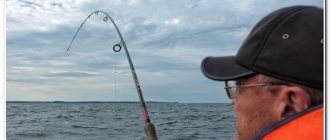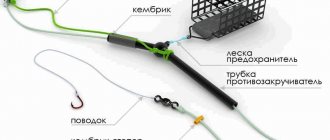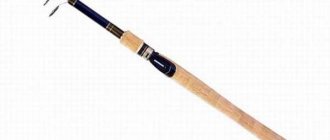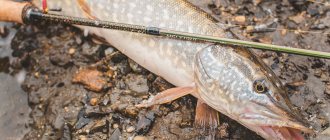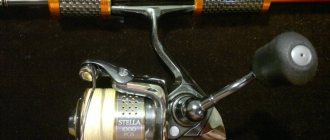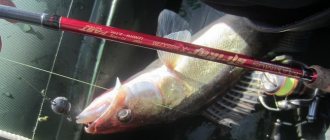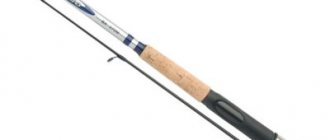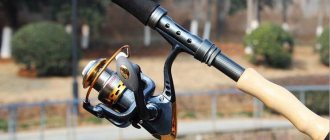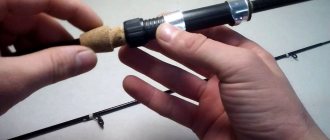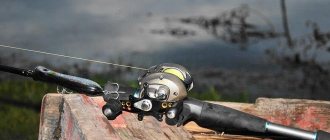Microjig baits weigh from 1 to 5 g (lures up to 1 g are more likely to be nanojigs, and weights from 4-5 g are more appropriate to medium jigs). A soft silicone or foam rubber bait is attached to a jig head hook or a swivel hook with a Cheburashka weight.
Microjig fishing requires the use of a good fishing rod that is as light and convenient to use as possible (often, to ensure this condition, spinning rods with a lightweight, spaced handle are used).
If everything is more or less clear with the rod test (indicators are 0-3, 0-5, 1-7 g and others), then the structure and design features deserve special attention. Regarding these parameters, the opinions of fishermen differ: some prefer a fast action with a moderately hard rod tip, others prefer a fast action with a soft, glued tip, and still others insist on choosing a rod with a medium action.
Stiff and fast rod for microjigging
If you plan to do intensive microjig fishing, then it is best to take a spinning rod with the mentioned glued tip.
A rigid and fast blank will allow you to perfectly control the bait you are using and convey its game. A more flexible tip will work like a nod on a winter fishing rod. The sensitive tip will allow the fisherman to see everything that happens to the bait: whether it falls in the thicker water, touches the bottom, hits an obstacle, or provokes fish activity.
The only drawback of this type of rod is its low level of versatility. Such a flexible tip will be inappropriate when fishing with spoons, spinners and wobblers, and twitching with such a rod is almost impossible.
Sensitive spinning rod tips
08.10.2014 admin
But no matter how sensitive the spinning rod is, its possibilities are not unlimited. In certain situations and when the mass of the bait is minimal, the spinning rod stops transmitting information to the angler’s hand about contact with the bottom or an obstacle. In this case, the spinning rod’s ability to visually convey changes in wiring comes to the fore. In this regard, rods with a “live tip” are best suited, which contributes to the best visual control of the movements of the bait when touching the bottom, contacting obstacles and, of course, when carefully biting fish.
All this, combined with the high sensitivity of the blank, allows the angler to receive maximum information about what is happening around his bait and respond to everything in a timely manner. Having experience in fishing with a variety of rods, including those designed for RockFish, I can say that, in my opinion, you shouldn’t get carried away of the tip of spinning rod Yes, glued (solid) tips have some advantages: they are soft and work well with baits at the lower limit of the dough, they provide the best visual perception of changes in the wiring that we are not able to feel with our hands.
But I give preference to high-quality standard fishing rods, since the use of spinning rods with a tip that resembles a nod for a winter fishing rod is very limited. There are certain problems when fishing in the current, it is very problematic to fish in heavily overgrown reservoirs, most of the advantages associated with visual contact come to naught when fishing in windy weather, and with such rods the desired animation is not always obtained. It must be said that the most accurate casts can be achieved using fast action rods.
This moment is very important, since all subsequent movements can safely be considered meaningless if after casting the bait hangs on the bushes. Don’t forget about the requirements for the power characteristics of fishing rods, which are best met by spinning rods with a powerful butt. A good example is the already mentioned Raptor-X MSRX762L; in a relatively small test (up to 10 g), its power characteristics are sufficient for forced fishing. I hope that, having an idea of the tools for breaking into a predator’s hiding place, some of the fishermen will decide to look into the most impenetrable underwater “wilds” before heading home, resigning themselves to the predator’s reluctance to leave its shelter.
These articles may interest you
- Night fishing for pike perch in the vicinity of Volgograd
- Burbot place
- Fishing box on skis
- Floats for fish and the correct selection of floats
- Which baits are better
- Winter lure “A-Elita” is the best of all
- Our gear
Recent Entries
- Fishing with dragnet
- Making Carolina rigs for pike and perch fishing
- How to equip a Volzhanka 46 Fish boat for fishing
- Winter fishing in Finland, what and how
- About setting up the jig when assembling winter tackle
- Fishing on the Tura River in winter in February
- The A-elita vent is visible from afar
- Winter lure “A-Elita” is the best of all
- How to attach a float rig to a fishing rod?
- Installation of float equipment for fly and plug fishing rods
Advanced site search
Group 1 below in site entries
Fast spinning action
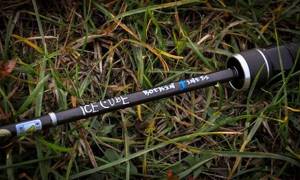
The second option is to use a fast spinning rod with a hard tip. High-quality (and, naturally, quite expensive) models of this class are also very sensitive and, when using non-stretchable braids, allow you to feel in your hand the wiring of a microjig bait weighing 1.5-2 g. This rod is more versatile in the ultralight category. They are good at using small spinners, spinners and wobblers, as well as light twitching.
Rating of budget spinning rods for microjig
- Graphiteleader Finezza. It is not without reason that this series of spinning rods occupies the first line of our rating. We deliberately do not specify the specific model. They all have the same microjig focus. It was Finezza who at one time revolutionized microjigging by introducing a spinning rod with a glued tip to the Russian market for the first time. A dozen years have passed since then, the Graphiteleader company has already released a certain number of models of various fines, but this spinning rod is still the standard in microjig fishing.
- Hearty Rise Rock'n'Force RF-692XUL with 0.5-5 grams of dough. In our opinion, a somewhat underrated spinning rod among anglers. Perhaps it’s all about banal promotion, but this spinning rod is not as popular among our fishermen as it is good. A distinctive feature, in addition to its microjigging qualities, is the skeletal, very modern and comfortable reel seat, sensors and excellent range of this model. A brief overview of this model can be read here
- Graphiteleader Bellezza Correntia 672 UL-BB-T. It is unlikely that many anglers associate this trout rod with microjigging. However, this spinning rod works ideally with weights from 0.5 to 5 grams and even the most sporty finger-sized perch is a great pleasure to catch with it;
- Evergreen Salty Sensation. We will not single out a specific model. Many anglers love this series for its superior sensory and bite sensation. These rods use the highest modulus carbon, which is found on Prototype spinning rods;
- Tict Ice Cube 69F. For many, this saltwater rod is the standard in microjig fishing. Having a stated test of 0.1-3.5 grams, it is used, as a rule, on the most common scales in microjig 1-2 grams of bait, as well as in mormyshing. It also copes well with various spinners, spoons and is used by some anglers in catching aryan and stream trout. Taking this into account, we can say that this is the most versatile spinning rod within its test;
- Favorite Exclusive EXS-792UL-T. This model of the Ukrainian manufacturer is included in this list because. the guys were one of the first, many years ago, to essentially copy Finezza. This spinning rod is similar both in appearance and in characteristics to the very first series of the legendary finez. This spinning rod is rightly called the Ukrainian Fineza, an excellent long-range all-rounder with an affordable price;
- Shimano Soare. These rods have already become a kind of household name in microjig. Like Finezza, there are many variations from the manufacturer: Ci4, BB, SS, X-Tune. They differ, essentially, in the modularity of carbon fiber, countries of manufacture and fittings, and, as a consequence, price. Needless to say, excellent micro jig spinning rods!
- In this line we will enter all the spinning rods of the Japanese company Major Craft, which have the Mebaru/Light Game and Aji subseries. These are Firstcast, Crostage, TripleCross, N-One and Truzer. The behavior of the forms of these series is very similar to each other, they have the same focus, but differ from each other mainly in the installed fittings. Because the production of products is carried out in China, and all products are closely monitored by the parent company, then we have good quality spinning rods at reasonable prices;
- Crazy Fish Ebisu Gold II. This rod, which unexpectedly appeared on the fishing market, aroused great interest among many athletes. Lightweight, perfectly balanced, and extremely sensitive, this spinning rod can now be seen among many athletes at coastal competitions. Despite its low price compared to other members of the list, it definitely deserves a high place in our ranking.
The video shows an example of how a spinning rod works
Major Craft TCX-S732UL
with dough 0.4-5 grams, belonging to the Light Game subseries:
Each fisherman has his own understanding of the term budget, so let’s immediately make a reservation and make some assumption that the term “budget” is a threshold below 5,000 rubles. For your reference, we will also make a reservation that we indicate the price of spinning rods as of June 2019, so at the time you read the article the price may be different.
- Favorite Blue Bird 16 and White Bird 16. The Favorite company was one of the first to understand the demand for microjigging spinning rods with a glued tip in the budget segment. The legendary “blue bird” and “white bird”, updated in 2021, are definitely worth the money and deserve attention;
We suggest you read: How to equip a spinning rod: description and choice of equipment, how to properly assemble a spinning rod and how to equip a spinning rod
- Black Hole Spy. It is more correct to consider this rod a universal ultralight that copes equally well with various types of baits. We would recommend it to those fishermen who, in addition to microjig fishing, plan to widely fish with miniature spoons or wobblers;
- Major Craft Firstcast. This spinning rod has replaced the well-known and popular Major Craft Solpara line. The line of these fishing rods is very large, which allows you to choose a specific model exclusively “for you”;
- Crazy Fish Ebisu II Violet. For many, a spinning rod at such a price with such parameters was a real discovery. These spinning rods can be found among many sports anglers participating in coastal competitions. All models in the series are very light, soft, with a delicate sensitive tip;
- Black Hole Rimer. Initially, the rockfish spinning rods of the BlackHole company were actively sold among fans of microjig and nanojig;
- Aiko Troutex II. This list contains all rods with fast and super-fast action. But this is not suitable for everyone. The updated Aiko Troutex trout series is suitable for those who want to use baits of the smallest weights. Having a medium action, spinning rods are well suited for jig fishing.
Medium action spinning rod for microjig
The last option is to use a spinning rod with a medium action, which has a moderately flexible tip that works together with 1/3 or ½ of the blank. Fans of this type of spinning rod for microjigging, among other things, also use stretchable, fairly bright monofilament instead of a cord.
Under such conditions, the wiring with bites is controlled not by hand or by the tip, but by the line itself, which is why its bright colors are selected. The advantage is the fairly high casting range. A flexible spinning rod dampens fish jerks well and “ties” it better, which is difficult when using a rigid rod. However, there is also a significant drawback: only a light breeze is enough to give the fisherman the agony of controlling the retrieve and bite.
Passing rings
One of the most important parts of a spinning rod is the guide rings. The purpose of the guide rings is not just to hold the cord, but also to ensure minimal friction between the ring and the fishing line.
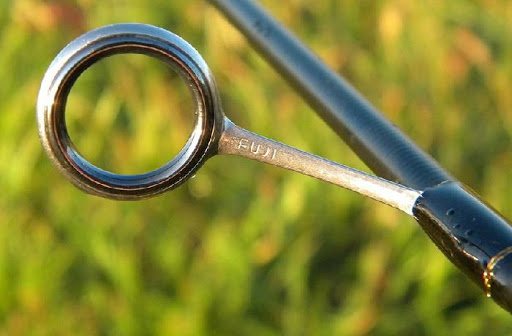
The material from which the rings are made plays an important role. The rings are of poor quality; from constant friction of the fishing line or cord against the ring, grooves form on the rings. Rings with such grooves literally wear out the fishing line in just a few casts and rewinds, which breaks during the next cast and the bait is shot. Bypass rings with defects cannot properly perform their intended functions and must be replaced.
You may be interested in: Shimano Stella FI Reel
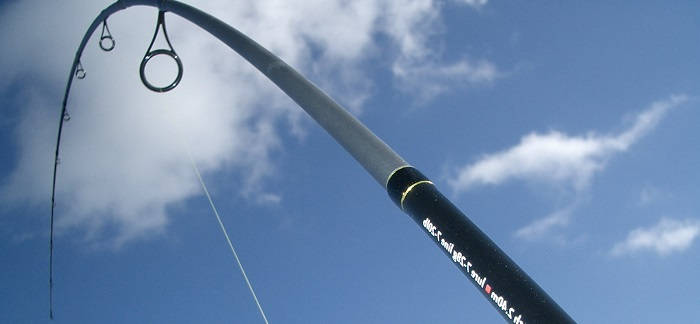
The number of throughput rings depends on the length of the spinning rod and the degree of its rigidity. The passage ring on the top of the spinning rod is called a “tulip”. Spinning rod guide rings can be made entirely of metal, or have a metal base with a ceramic, Teflon or fluoroplastic insert inside the ring. The best rings today are those with Alconite (black) and SIC (gray) inserts.
The inserts must be firmly held inside the passage rings without turning. The guide rings themselves must be firmly and tightly wound with thread to the rod blank.
Pike perch on microjig
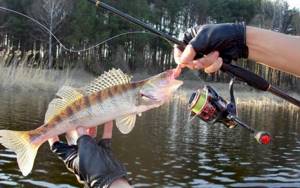
As a result, we can say that all three considered rod options have their advantages and disadvantages. The choice of models is quite large, so you can find fishing rods of different prices. And what rod structure and design to choose is an individual decision for each fisherman.
Feeder fishing for beginners
Probably every angler has heard about feeder tackle, but he doesn’t even imagine what advantages a feeder has over a regular donkey. Let's first figure out what feeder tackle is. Feeder is an English don. Developed by the British a long time ago, it appeared on our market only ten years ago and since then has completely turned the ordinary world of the fisherman upside down. Now there are more and more fans of the feeder every year.
The feeder is not as simple as it seems, and this feature comes from the fact that in this gear everything is not as simple as in a spinning rod or a float rod. Essentially, a feeder is a rod with a tip that bends when biting, which signals us that it’s time to hook. Each feeder is equipped with three replaceable tips. Each tip is ideal for certain fishing conditions. The tips can be divided according to their hardness, namely hard, medium hard and soft. As usual, we choose our tip for a certain fish, so it’s better to catch roach or crucian carp with a soft tip, and carp with a hard tip. The feeder mainly consists of three parts.
The feeder is divided into butt, main and signal parts. The butt is the thickest and most powerful part in any feeder; it is the butt that determines what size we can catch fish, and, in general, what restraining resource the tackle has. The middle part is responsible for holding the fish, and as many anglers say, it knits. But the tip signals a bite. For different fishing conditions, different feeder rods with different test and action are selected. You probably already know what a system is. Stroke is the speed at which the tip returns to its original position after a swing. Do not think that the feeder has only one system; in fact, the system of the feeders is different and it depends on the personal preferences of the angler and the intended fish. Feeder rods are also divided into classes. Heavy, medium and light. Light feeders are usually called pickers. In general, the feeder was designed for fishing using feeders. So, when fishing with a feeder, feeders of various sizes and shapes are used, and for comfortable fishing you must take into account the limits of the upper dough and the weight of the feeder itself. Now let's talk about which feeder to choose for certain fishing conditions; I will say right away that cost is not the determining factor in the gear.
Feeder selection and price factor
To buy a good feeder tackle, you don’t need to have a large wallet of money, since in the cheap segment you can quite easily find decent tackle that will satisfy your fishing desires. So for three thousand rubles you can buy a feeder with a fast action and a full set of tips. Cheap tackle will differ only in that it is slightly heavier than expensive feeder rods and is made of inexpensive material.
As usual, all feeder rods are made of composite materials or high quality carbon. For a novice fisherman, I would recommend choosing a feeder made of carbon rather than graphite. Carbon is a very light and flexible material. Also, if you are just starting to get acquainted with feeder tackle, then it is better to choose a rod with a slow action, which will tie the fish literally from the butt part, in this case you will have a minimum of departures, and the casting will be extremely far and accurate.
But a feeder is not just a rod, it is also a reel equipped with fishing line or braid. I won’t lie if I say that it is best to equip the feeder with braided fishing line rather than with ordinary monofilament. The braid has no stretch and is very durable. Since there is no stretchability, the sensitivity of the gear increases significantly. The main features of a feeder reel are that it should be large and have a good gear ratio. The use of a large reel is justified by the fact that with a small reel it is inconvenient to cast as far as possible.
Since a large reel has a shallow, impressively sized spool, the casting is much further, and a powerful and large rotor will allow you to cope with fish of considerable size, we also pay attention to the friction brake and smoothness of motion. To be honest, it’s better not to skimp on the feeder reel, because this is practically the main unit in the entire tackle. It is advisable to choose a reel with a large knob, as it is more convenient to perform power hooking over a long distance. But the acquaintance with the feeder does not end there; let’s move on to such a part as auxiliary devices for fishing.
Accessories
Auxiliary devices include a chair, a stand for the feeder and a soft bucket, a landing net, and a cage. Each of these devices performs its role. So, it is better to choose a soft stand for the feeder and such that the length can be very easily adjusted, and you will spend a very long time fishing on a soft chair, so everything should be ergonomic and elegant. You will mix the bait in the bait bucket, so you shouldn’t cheap out on this. Every self-respecting angler who loves English donka will always have a large number of different-sized feeders for various fishing conditions. Every novice fisherman should have everything, but at a minimum, so that you understand what is best to fish for and which feeder to give preference to. What hooks and rigs to use. Now let's move on to such a component as choosing a place for fishing.
Choosing a place for fishing on a feeder
There is simply no such universal equipment as a feeder. You can fish with a feeder on large rivers with decent depth and current, but the length of the feeder must be appropriate, because the current makes its own adjustments to fishing. If you fish on a large river, then you will need closed type feeders, and you will need a very powerful feeder with a large top dough, say up to one hundred and eighty grams, and a medium action will be useful
rigidity. Fishing is also very promising in quiet places such as ponds and lakes. Recently, carp fishing with a feeder on pay platforms has been gaining popularity. For such a case, we will need a specialized feeder and a reel with a baitrunner. All of the above applies to the global choice of location, and now let’s talk about how to choose a location on a pond. Each body of water has its own specific relief, which directly affects the outcome of fishing. For a novice angler, I recommend first determining the depth at the fishing spot and the distance that is optimal for your feeder. Having decided on the casting distance, we begin to look for local areas under water. This is done very simply. A round sinker is hung at the end of the feeder and we simply drag the weight along the bottom the entire length of the cast and determine the presence of holes, edges or drops. Of course, this is a bit difficult for a novice fisherman, but for fun, you first need to prepare a solid foundation, and only then start fishing. The optimal choice would be to choose a level table, here the bait will be in one place and will not fall off anywhere, the same will happen with the bait. Having chosen a fishing point, we begin feeding, several feeders with bait and the third main one - this is enough for fishing!
Try, catch, try and you will succeed. She's such an English don!
